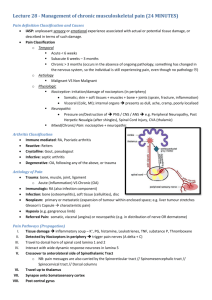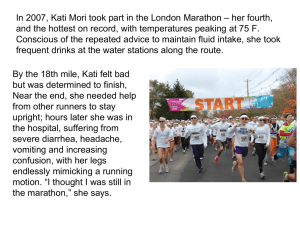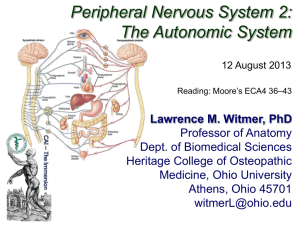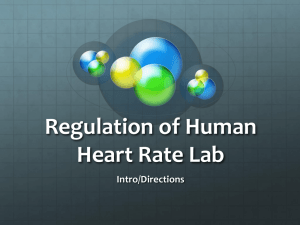Anatomy and Physiology of Pain
advertisement
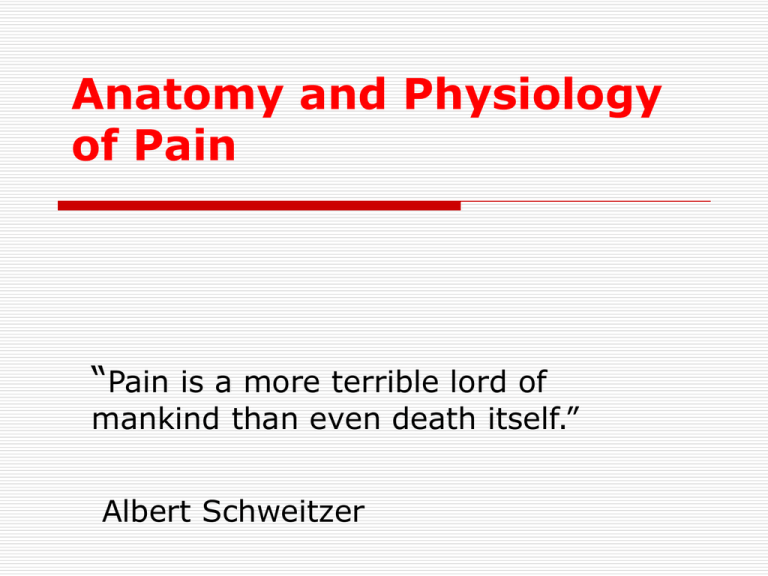
Anatomy and Physiology of Pain “Pain is a more terrible lord of mankind than even death itself.” Albert Schweitzer Pain definitions: (The International Association for the Study of Pain (IASP) An unpleasant sensory and emotional experience associated with actual or potential tissue damage May not be directly proportional to amount of tissue injury This definition recognizes that pain is a perception and not a sensation!! Pain definitions: (hierarchical model of pain) Pain is whatever the experiencing person says it is Pain definitions - implication of both the IASP and the hierarchical model of pain As a perception, pain may or may not correlate with an identifiable source of injury The activity in the body’s “nociceptive” system, which senses noxious stimuli and generates a physiological and behavioral response, can be initiated by injury and sustained by neuroplastic changes even after healing activity in this system can occur in the absence of any discrete injury but in association with a recognizable disease Pain definitions - implication of both the IASP and the hierarchical model of pain In some cases, pain can develop and be unrelated to any identifiable physical process In all cases, the reality that pain is a perception indicates the potential for: profound influence of psychological and emotional factors, cognitions and varied external events Pain definitions - implication of both the IASP and the hierarchical model of pain - concept of pain as perception It is almost always best to believe that the patient is experiencing what is being reported. Because there is no objective indicator for pain, experts agree that the best clinical approach in most circumstances is to assume that the patient is reporting a true experience, even in the absence of a clear explanation. Importantly, accepting a patient’s complaint of pain as valid does not require clinical identification of a physical cause, or demand the initiation of a specific treatment. Pain definitions - implication of both the IASP and the hierarchical model of pain - concept of pain as perception Almost always, it is a sound foundation for assessment and an important beginning in developing an effective physician-patient dialogue. The risk that rare cases of malingering or factitious disorder may lead the credulous physician to initial error is more than balanced by the benefits associated with a stance of compassionate acceptance and concern. Types of Pain 1.Acute - a protective mechanism that alerts the individual to a condition or experience that is immediately harmful to the body; Onset - usually sudden 2.Chronic - is persistent or intermittent usually defined as lasting at least 6 months Types of Pain Responses to acute pain diaphoresis pallor or flushing increased heart rate elevated blood pressure blood flow to the viscera, kidney and skin gastric acid secretion gastric motility nausea occasionally occurs increased respiratory rate dilated pupils blood sugar fear general sense of unpleasantness anxiety Types of Pain - response to chronic pain Psychological response Intermittent pain produces a physiologic response similar to acute pain Persistent pain allows for adaptation (functions of the body are normal but the pain is not reliefed) Chronic pain produces significant behavioural and psychological changes: depression an attempt to keep pain - related behaviour to a minimum sleeping disorders preoccupation with the pain tendency to deny pain Pain threshold and pain tolerance The pain threshold - the point at which a stimulus is perceived as pain. It does not vary significantly among healthy people or in the same person over time Perceptual dominance - intense pain at one location may cause an increase in the pain threshold in another location The pain tolerance - duration of time or the intensity of pain that an individual will endured before initiation overt pain responses. It is influenced by: - persons cultural prescriptions - expectations - role behaviours - physical and mental health Pain threshold and pain tolerance Pain tolerance is generally decreased: with repeated exposure to pain by fatigue, anger, boredom, apprehension sleep deprivation Tolerance to pain may be increased: by alcohol consumption medication, hypnosis warmth, distracting activities strong beliefs or faith Pain tolerance varies greatly among people in the same person over time a decrease in pain tolerance is also evident in the elderly women appear to be more tolerant to pain than men Age and perception of pain Children and the elderly may experience or express pain differently than adults: Infants in the first 1 to 2 days of life are less sensitive to pain (or they simply lack the ability to verbalise the pain experience) A full behavioural response to pain is apparent at 3 to 12 month of life Older children, between the ages of 15 and 18 years, tend to have a lower pain threshold than do adults Pain threshold tends to increase with ageing this change is probably caused by peripheral neuropathies and changes in the thickness of the skin Clasification of Pain by pathophysiology 1. Nociceptive pain (stimuli from somatic and visceral structures) 2. Neuropathic pain (stimuli abnormally processed by the nervous system) 3. Psychogenic pain is pain for which there is unknown physical cause but processing of sensitive information in CNS is dysturbed 4. mixed pain 5. idiopathic pain Nociceptive Pain and its Mechanisms Clinically, pain can be labeled “nociceptive” if it is inferred that the pain is due to ongoing activation of the nociceptive system by tissue injury. Although neuroplastic changes (such as those underlying tissue sensitization) are clearly involved, nociceptive pain is presumed to occur as a result of the normal activation of the sensory system by noxious stimuli, a process that involves 4 basic processes Transduction Transmission Perception of pain Modulation of pain Nociceptive Pain and its Mechanisms Tissue injury activates primary afferent neurons called nociceptors, which are small diameter afferent neurons (with A-delta and C-fibers) Nociceptors respond to noxious stimuli Nociceptors are found in skin muscle joints and some visceral tissues. Nociceptive Pain and its Mechanisms Nociceptive primary afferent neurons are varied: Most are “silent” - active only when suprathreshold stimuli impinge Some are specific to one type of stimulus, such as mechanical or thermal but most are polymodal The number and size of the receptive fields served by each fiber may be small or large, respectively Nociceptive Pain and its Mechanisms nociceptors free nerve endings has capacity to distinguish between noxious and innocuous stimuli when exposed to mechanical (incision or tumor growth) thermal (burn) chemical (toxic substance) stimuli tissue damage occurs substances are released by the damaged tissue which facilitates the movement of pain impulse to the spinal cord Substances released The substances released from the traumatized tissue are: prostaglandins bradykinin serotonin substance P Histamine Protons NGF The role of this substances provide opportunities for the development of new analgesic drugs So, for instance Non-steroidal anti-inflammatories, such as ibuprofen, are effective in minimizing pain because they minimize the effects of these substances released, especially prostaglandins Corticosteroids, such as dexamethasone used for cancer pain, also interferes with the production of prostaglandins 1. Transduction sufficient amounts of noxious stimulation cause the cell membrane of the neuron (nervous system cell) to become permeable to sodium ions, allowing the ions to rush into the cell and creating a temporary positive charge then potassium transfers back into the cell, thus changing the charge back to a negative one with this depolarization and repolarization, the noxious stimuli is converted to an impulse this impulse takes just milliseconds to occur Some analgesics relieve pain primarily by decreasing the sodium and potassium transfers at the neuron level, thereby slowing or stopping pain transmission Examples—local anesthetics, anticonvulsants used for neuropathic pain, migraines 2.Transmission Once depolarization occurs, transmission of information proceeds proximally along the axon to the spinal cord and then on to higher centers. 2.Transmission Transmission across the first central synapse may be influenced by activity in the primary afferent itself and modulatory neural pathways that originate segmentally or supraspinally further modulation results from processes initated by glial cells. 2.Transmission Impulse spinal cord brain stem thalamus central structures of brain pain is processed Neurotransmitters are needed to continue the pain impulse from the spinal cord to the brain 3. Perception of Pain the end result of the neural activity of pain transmission it is believed pain perception occurs in the cortical structures behavioral strategies and therapy can be applied to reduce pain brain can accommodate a limited number of signals — distraction, imagery, relaxation signals may get through the gate, leaving limited signals (such as pain) to be transmitted to the higher structures 4.Modulation of Pain The neurochemistry of these processes involves an extraordinary array of compounds, including endorphins, neurokinins, prostaglandins, biogenic amines, GABA, neurotensin, cannabinoids, purines, and many others. 4.Modulation of Pain The endorphinergic pain modulatory pathways are characterized by multiple endogenous ligands and different types of opioid receptors: mu, delta, and kappa. Endorphins are present in the periphery, on nerve endings, immune-related cells and other tissues, Endorphins are widely distributed in the central nervous system (CNS). They are involved in many neuroregulatory processes apart from pain control, including the stress response and motor control systems. Opioid drugs mimic the action of endogenous opioid ligands. Most of the drugs used for pain are full mu receptor agonists. 4.Modulation of Pain Other pain modulating systems, such as those that use monoamines (serotonin, norepinephrine and dopamine), histamine, acetylcholine, cannabinoids, growth factors and other compounds, are targets for nontraditional analgesics, such as specific antidepressants and anticonvulsants. It is likely that entirely novel analgesic compounds will become commercially available in the future as drug development programs target these systems. 4.Modulation of Pain changing or inhibiting pain impulses in the descending tract (brain spinal cord) descending fibers also release substances such as norepinephrine and serotonin (referred to as endogenous opioids or endorphins) which have the capability of inhibiting the transmission of noxious stimuli cancer pain responds to antidepressants which interfere with the reuptake of serotonin and norepinephrine which increases their availability to inhibit noxious stimuli Clinical Characteristics of Nociceptive Pain acute (short-lived, remitting) persistent (long-lived, chronic), primarily involve injury to somatic or visceral tissues. “somatic pain”- pain related to ongoing activation of nociceptors that innervate somatic structures, such as bone, joint, muscle and connective tissues, this pain is recognized by identification of a lesion characterisitics typically include a well localized site and an experience described as aching, squeezing, stabbing, or throbbing. Clinical Characteristics of Nociceptive Pain Arthritis and metastatic bone pain are examples of somatic pain. Pain arising from stimulation of afferent receptors in the viscera is referred to as visceral pain. Visceral pain caused by obstruction of hollow viscus is poorly localized and is often described as cramping and gnawing, with a daily pattern of varying intensity. when organ capsules or other structures such as myocardium, are involved, however, the pain usually is well localized and described as sharp, stabbing or throbbing, descriptors similar to those associated with somatic pain. Clinical Characteristics of Nociceptive Pain Nociceptive pain may involve acute or chronic inflammation. The physiology of inflammation is complex. an immune component retrograde release of substances from C polymodal nociceptors - “neurogenic inflammation” - involves the release from nerve endings of compounds such as substance P, serotonin, histamine, acetylcholine, and bradykinin. these substances activate and sensitize other nociceptors. Prostaglandins produced by injured tissues also may enhance the nociceptive response to inflammation by lowering the threshold to noxious stimulation. Neuropathic Pain and its Mechanisms abnormal processing of the impulses either by the peripheral or central nervous system may be caused by injury (amputation and subsequent phantom limb pain) scar tissue from surgery (back surgery high risk) nerve entrapment (carpal tunnel) damaged nerves (diabetic neuropathy) unclear why depolarization and transmission of pain impulse are spontaneous and repetitive Neuropathic Pain and its Mechanisms It occurs as a result of injury to or dysfunction of the nervous system itself, peripheral or central Deaferentation pain - form of neuropathic pain: a term implying that sensory deficit in the painful area is a prominent feature (anesthesia dolorosa) Phantom pain- pain localised into non-existing organ (tissue) Long-lasting pain after short-lasting pain stimulus Clinical Manifestation of Pain Acute Pain Somatic Visceral Reffered pain Somatic pain is superficial coming from the skin or close to the surface of the body. Visceral pain refers to pain in internal organs, the abdomen, or chest. Referred pain is pain that is present in an area removed or distant from its point of origin. The area of referred pain is supplied by the nerves from the same spinal segment as the actual site of pain. Different types of chronic somatic pain I. Nervous system intact 1. nociceptive pain 2. nociceptive - neurogenic pain (nerve trunk pain) II. Permanent functional and/or morphological abnormalities of the nervous system (preganglionic, spinal supraspinal) 1. neurogenic pain 2. neuropathic pain 3. deafferentation pain The most common chronic pain 1. Persistent low back pain result of poor muscle tone, inactivity, muscle strain, sudden vigorous exercise 2. Chronic pain associated with cancer The most common chronic pain 3. Neuralgias Causalgia - - results from damages of peripheral nerves severe burning pain appearing 1 to 2 weeks after the nerve injury associated with discoloration and changes in the texture of the skin in the affected area. Reflex sympathetic dystrophies - occur after peripheral nerve injury and is characterised by continuous severe burning pain. Vasomotor changes are present (vasodilatation vasoconstriction cool cyanotic and edematous extremities). The most common chronic pain 4. Myofascial pain syndromes - second most common cause of chronic pain. include: myositis, fibrositis, myalgia, muscle strain, injury to the muscle and fascia The pain is a result of muscle spasm, tenderness and stiffness The most common chronic pain 5. Hemiagnosia a loss of ability to identify the source of pain on one side (the affected side) of the body. Application of painful stimuli to the affected side thus produces anxiety, moaning, agitation and distress but no attempt to withdrawal from or push aside the offending stimulus. Emotional and autonomic responses to the pain my be intensified. ● Hemiagnosia is associated with stroke that produces paralysis and hypersensitivity to painful stimuli in the affected side 6. Phantom limb pain - is pain that an individual feels in amputated limb Pathophysiology of muscle pain (MP) MP - a part of somatic deep pain, it is common in rheumathology and sports medicine is rather diffuse and difficult to locate MP is not a prominent feature of the serious progressive diseases affecting muscle, e.g. the muscular dystrophies, denervation, or metabolic myopathies, but it is a feature of rhabdomyolysis Muscles are relatively insensitive to pain when elicited by needle prick or knife cut, but overlying fascia is very sensitive to pain. Events, processes which may lead to muscular pain are: metabolic events: metabolic depletion ( ATP muscular contracture) accumulation of unwanted metabolities (K+, bradykinin) Pathophysiology of visceral pain Visceral pain: Types - angina pectoris, myocardial infarction, acute pancreatitis, cephalic pain, prostatic pain, nephrlolytiatic pain Receptors: unmyelinated C – fibres For human pathophysiology the kinds of stimuli apt to induce pain in the viscera are important. It is well-known that the stimuli likely to induce cutaneous pain are not algogenic in the viscera. This explains why in the past the viscera were considered to be insensitive to pain Adequate stimuli of inducing visceral pain: • 1. abnormal distention and contraction of the hollow viscera muscle walls 2. rapid stretching of the capsule of such solid visceral organs as are the liver, spleen, pancreas... 3. abrupt anoxemia of visceral muscles 4. formation and accumulation of pain - producing substances 5. direct action of chemical stimuli (oesophagus, stomach) 6. traction or compression of ligaments and vessels 7. inflammatory processes 8. necrosis of some structures (myocardium, pancreas) Characteristic feature of true visceral pain a) it is dull, deep, not well defined, and differently described by the patients b) sometimes it is difficult to locate this type of pain because it tends to irradiate c) it is often accompanied by a sense of malaise d) it induces strong autonomic reflex phenomena (much more pronounced than in pain of somatic origin) - diffuse sweating, vasomotor responses, changes of arterial pressure and heart rate, and an intense psychic alarm reaction -"angor animi" - in angina pectoris) There are many visceral sensation that are unpleasant but below the level of pain, e.g. feeling of disagreeable fullness or acidity of the stomach or undefined and unpleasant thoracic or abdominal sensation. These visceral sensation may precede the onset of visceral pain Refered visceral pain (transferred pain) Refered pain = when an algogenic process affecting a visceral recurs frequently or becomes more intense and prolonged, the location becomes more exact and the painfull sensation is progressively felt in more superficial structures Refered pain may be accompanied by allodynia and cutaneous and muscular hyperalgesia Mechanisms involved in refered pain creation: convergence of impulses from viscera and from the skin in the CNS: Sensory impulses from the viscera create an irritable focus in the segment at which they enter the spinal cord. Afferent impulses from the skin entering the same segment are thereby facilitated, giving rise to true cutaneous pain. senzitization of neurons in dorsal horn Refered visceral pain (transferred pain) Painful visceral afferent impulses activate anterior horn motor cells to produce rigidity of the muscle (visceromotor reflexes) A similar activation of anterolateral autonomic cells induces pyloerection, vasoconstriction, and other sympathetic phenomena These mechanisms, which in modern terms can be defined as positive sympathetic and motor feedback loops, are fundamental in refered pain It is clear that painful stimulation of visceral structures evokes a visceromuscular reflex, so that some muscles contract and become a new source of pain Refered visceral pain (transferred pain) It has been observed that the local anesthetic block of the sympathetic ganglia led to the disappearance, or at least to a marked decrease, of refered pain, allodynia, hyperalgesia. In some conditions, reffered somatic pain is long-lasting, increases progressively, and is accompanied by dystrophy of somatic structures. Possible mechanisms: onset of self-maintaining vicious circle impulses: peripheral tissue afferent fibers central nervous system peripheral tissue somatic and sympathetic efferent fibres Intricate conditions - in some types of pain, e.g. chest pain, is difficult to distinguish the true cause of pain because such kind of pain may be related to cervical osteoarthrosis, esophageal hernia, or cholecystitis. It is difficult to ascertain whether these intricate conditions are due to a simple addition of impulses from different sources in the CNS or to somatovisceral and viscerosomatic reflex mechanisms. It has been demonstrated that the mnemonic process is facilitated if the experience to be retained is repeated many times or is accompanied by pleasant or unpleasant emotions. Pain is, at least in part, a learned experience - e.g. during the first renal colic, true parietal pain followed visceral pain after a variable interval. In subsequent episodes of renal colic pain, parietal pain developed promptly and was not preceded by true visceral pain. This is probably due to the activation of mnemonic traces. Silent myocardial ischemia (SMI) Chest pain is only a late and inconstant marker of episodes of transient MI in vasospastic angina (30 %), in stable angina (50 %) 1. Mechanisms of SMI a) Lack of the pain is, in part, related to the duration and severity of MI. 1. Episodes shorter than 3 min, and those accompanied by a modest impairment of left ventricle ( in enddiastolic pressure inferior to 6 mm Hg) are always painless. 2. Longer and more severe episodes are acccompanied by chest pain in some instances but not in others. b) Pacients with predominantly SMI appear to have a generalized defective perception of pain (threshold and tolerance). Mechanism: level of circulating -endorphin (?) Disturbances in pain perception and nociception Most of the disturbances are congenital a) Congenital analgesia - nociceptive stimuli are not processed and/or integrated at a level of brain. Patient does not feel a pain b) Congenital sensoric neuropathy - nociceptive stimuli are not transmitted by peripheral nerves or by spinal afferent tracts. Acquired disturbances in pain perception and nociception They may occur at syringomyely, disturbances of parietal lobe of brain, in patients suffering from neuropathy (e.g. chronic diabetes mellitus)
